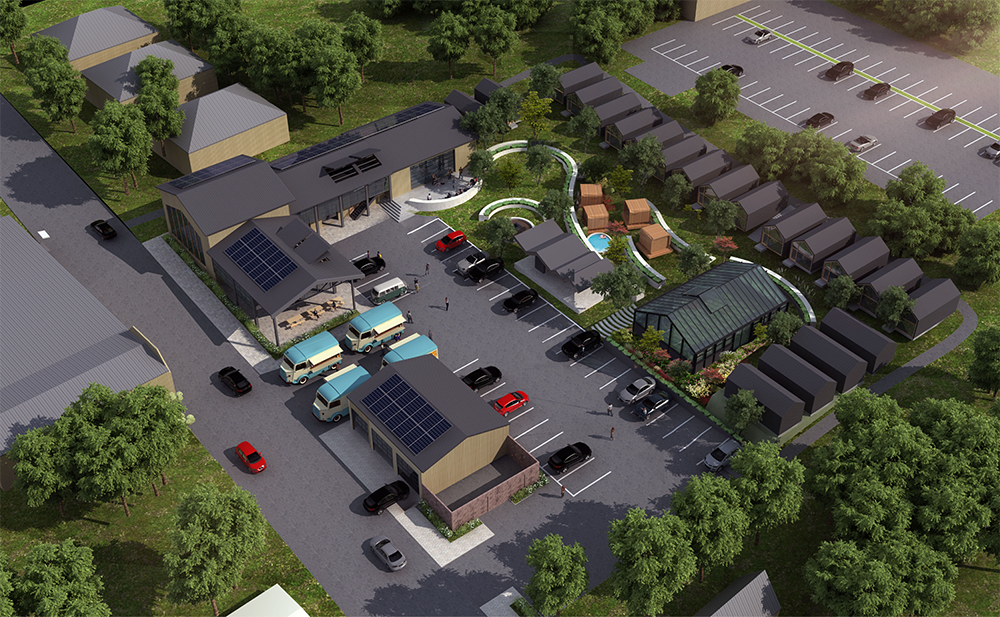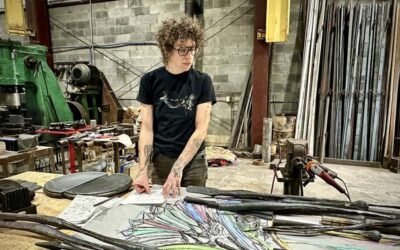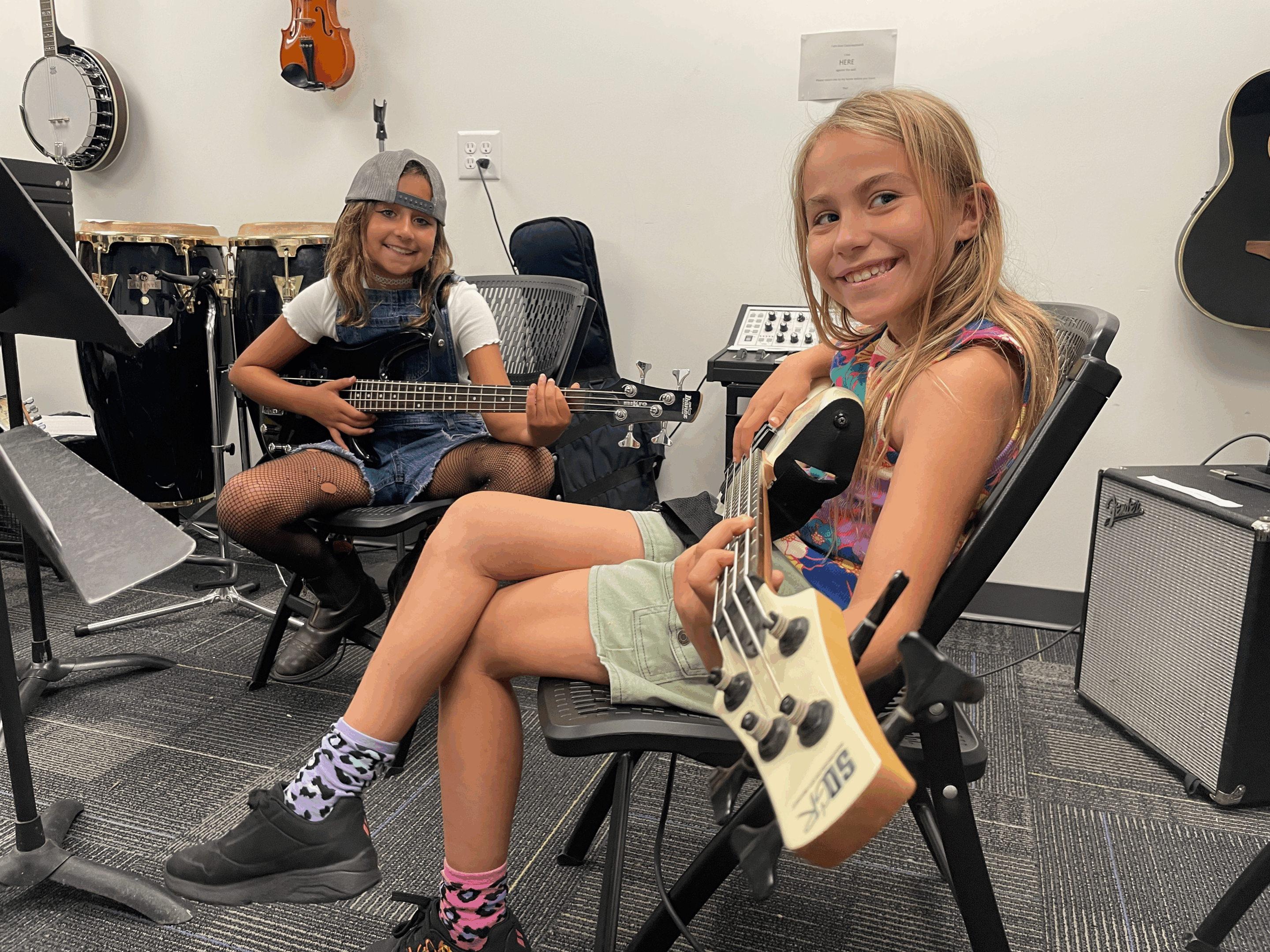
Blue Note Junction rendering | Alliance Architecture
Blue Note Junction’s Sustainable Community Vision
Asheville’s first community-owned real estate project supports BIPOC artists and entrepreneurs
March 19, 2024 | What does a successful, sustainable creative space look like in Buncombe County? As part of the Creative Spaces Report, ArtsAVL is excited to showcase profiles of local creative spaces responding to a critical lack of affordable living and work space in Buncombe County. The first in the series is Blue Note Junction, a community health and business incubator dedicated to BIPOC entrepreneurs and artists. Asheville’s first community-owned real estate project, Blue Note Junction will be located in the historically Black Burton Street neighborhood of West Asheville. The goal of its founders? To build an economic engine and cultural hub that supports BIPOC makers, entrepreneurs, and growers throughout the region.
The location of Blue Note Junction in a historically Black community in Asheville deliberately centers residents and their voices. The Burton Street neighborhood is already home to the Peace Gardens & Market, a vibrant outdoor space and community destination. Blue Note Junction’s co-founders, DeWayne Barton and Safi Martin, created the Gardens in the early 2000s, envisioning a place that would support an inclusive culture of sustainability.
Black-owned businesses account for fewer than 2.3% of business ownership nationwide. The creative sector in Buncombe County was hard hit during the Covid-19 pandemic, and recovery was slower than at national levels. Asheville is more expensive than 98% of North Carolina, and rents have also risen 41.7% since 2020, pricing out many creatives, especially BIPOC artists. Not only will Blue Note Junction provide a needed business incubator for BIPOC entrepreneurs and artists, it will also function as a model for commercial real estate and will have a larger impact on community health, driving benefits to investors, community partners, tenants, visitors, and the local economy.
Blue Note Junction also takes a broad, varied approach to community building, opening the way for a wide variety of tenants who will bring a diversity of offerings to the space. Planned tenants include an indoor and outdoor performance venue, an outdoor community spa, a fresh market, a garage for Hood Tours, a commercial kitchen, a co-working space, a counseling center, a hair salon and barber shop, an artist studio village, and a Black history tour. It will also include affordable housing: four two-story quadruplexes of 400-500-square-foot studios that can be used as live/work spaces.
Asheville Creative Arts (ACA) will be an anchor tenant, occupying Blue Note Junction’s indoor performance space, a flexible black box theater. Abby Felder, an ACA contributing artist, shares that “Many artists and the spaces which are serving artists’ needs are being priced out of the city, and for artists of color, this is especially impactful. Early studies conducted by ArtsAVL pointed to the need for the type of live/work spaces Blue Note Junction will provide, which will help to shore up Asheville’s arts ecosystem.”
The plans for Blue Note Junction tap into existing resources, including the Burton Street Neighborhood Plan, says Felder. That allows the team to serve community needs and “add capacity to local efforts to preserve a culture facing erasure due to highway expansions and changing neighborhood demographics.”
Martin defines success in two ways: how Blue Note Junction supports training and development and how the community uses it. “My two primary hopes are that Blue Note Junction serves as a platform for us to be able to do workforce development,” she says. “We work with a lot of young people who are trying to find their way into a living wage, [and for whom] traditional education hasn’t worked well. We want to provide learning on the job so that the young people help us build Blue Note Junction.” Ideally, that early opportunity will support long-term relationships and future careers.
As with the Peace Gardens, the other marker of success is whether “the actual Burton Street community sees Blue Note Junction as something belonging to them,” she says.
“One thing we found over time with the Peace Gardens, which has been designed as a safe space in the community, is that folks in general – and BIPOC folks in particular – come into the space because it is centered around BIPOC culture and Black history,” Martin continues. “We want to carry that same spirit into Blue Note Junction, where folks trying to start or grow their businesses see themselves reflected in the space where they’re doing business.”
A facet Martin is particularly excited about is the project’s focus on wellness. “If you’re taking an entrepreneurial journey or trying to make a living off your creativity, it brings a whole level of stress than if you’re going to a job. One thing really special about Blue Note Junction is that we are trying to cultivate a balance between taking good care of yourself and counteracting that stress while you navigate the journey of entrepreneurship.”
“Having DeWayne and Safi as project leadership embedded in the community and making efforts to ensure community voices are centered and platformed throughout is an important strategy to leverage the power of the arts in placekeeping,” says Felder. “That is to say, amplifying the culture and history already present in Burton Street, which we hope can be a model to replicate in other locales.”
The team is finalizing plans, with the goal of submitting them for approval in April. Besides navigating challenges with specific zoning and building restrictions in the area (which Martin notes were actually created to support sustainable community development), Martin notes that they “have been really blessed” by community support.
The project’s first phase could begin in late 2024 or early 2025 and would include the greenhouse, open-air market, outdoor event venue, gardens, and art installations. Phase 2 would target the affordable housing and commercial side of the operation. The target completion date is currently the end of 2027.
Stay tuned for more profiles of creative spaces, and for ArtsAVL’s Creative Spaces Report, which will assess the local creative landscape to provide crucial information for understanding the current reality and possible paths forward for the creative community. Visit artsavl.org/spaces for project updates and register for the upcoming Town Hall (May 10).
Related Article
Whimsy and Wonder: Storybook Trolls and Reclaimed Wood Art Transform The North Carolina Arboretum
Whimsy and Wonder: Storybook Trolls and Reclaimed Wood Art Transform The North Carolina...
A New Chapter for the Asheville Urban Trail
Photo courtesy of Red Metal A New Chapter for the Asheville Urban Trail After more than two...
ArtsAVL Announces 2025–26 Grassroots Arts Grants for 49 Local Arts Nonprofits
Photo courtesy of Asheville Music School ArtsAVL Announces 2025–26 Grassroots Arts Grants for 49...



